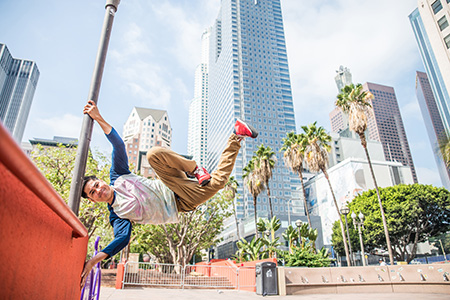Play to Prepare by Mark Toorock
We’ve all watched kittens play, and naturally understood that this play is a tool for learning about the world around them. Through play, kittens learn vital skills that would be used as an adult in the wild, from hunting to marking their territory to communicating to others that the food they just gained belongs to them and will be defended. Through play, they learn “how much” defense is necessary with siblings, and with others.
Most animals have similar patterns of behavior. Gorillas play fight* and also play “tag” just like human children. “Such games likely help the apes — and humans — learn how to deal with real conflict by testing what is acceptable with a safe crowd of peers and even parents.” Davila Ross said.
In my own personal experience owning a CrossFit and Parkour gym in the heart of Washington, DC for over 15 years, I have seen the effects of play firsthand. Children who engage in physical play lead generally happier lives. There is an element to play (physical play, not just board games or video games) that not only releases chemicals that make you temporarily feel happier but also trains the human system to more readily be able to release hormones and reward ourselves with a good feeling for having moved.
Teaching children the joy of movement at a young age is vital to develop habits and a love for movement that will last a lifetime. Finding an activity they enjoy is a critical part of this, whether that’s a team sport, individual or action sport, or hiking, climbing, and other physical activities.
Children who play physically not only maintain better physical health, they also keep a sense of curiosity, a pliability to adapt to the “now” and the ability to make quick decisions and actions based on what is happening around them. Essentially, most forms of play make good practice for scenarios when ourselves or others might be in actual danger. By working these same systems, both physical and mental, we are much better prepared to handle real-world scenarios when they arrive. We’re able to be more clear-headed and act without panic.
Kids who have done martial arts are better prepared, but also less likely, to fight – “Central to this was that martial arts reduced the rate of externalizing behaviors in participants. Externalizing behaviors included, but were not limited to, physical aggression, verbal and physical bullying, theft and vandalism. Through the teaching and practices of martial arts, participants were better able to gain a sense of control over both the situations and themselves, leading to less negative emotional responses and violent behaviors.”**
This emotional control doesn’t stop at threats of violence; from my own experience, it extends as a reflection of the deep calm often sought through meditation, which can be summed up externally as “self-confidence”. Self confidence, in essence, is “the assuredness brought about by belief in yourself”.
The only true way to gain this belief in yourself is through testing and practice – hence “Play”.
I taught martial arts to kids for several years. Then, when I found parkour, I saw that it is a perfect mix of what kids need. In parkour, kids gain the self-confidence of testing their physical abilities, but through movement challenges instead of “kata” or fighting forms. The main reason I prefer parkour for kids is autonomous creativity. All too often now, our kids are told exactly what to do and how to do it. There is a right and wrong answer, and testing to homogenize everyone. While this works for some forms of education, it is not an optimal preparation for the real world where we must each find and use our strengths and acknowledge and find ways to avoid or complement our weaknesses.
Parkour allows children the creativity to “find their own path” through a challenge or obstacle course, which uses a part of the brain rarely relied on in their other activities – the part that allows them to come up with solutions on their own instead of being given a set of “correct” answers. I have found that this skill transfers to many other areas of their life where they need to make a decision on their own.
My personal mission is to help extend play into everyone’s lives. As kids, we’re often told “Get down from there, you’ll get hurt.” when often quite the opposite is true! By allowing our children to climb – albeit safely, at reasonable heights, and at developmentally appropriate challenge increments – they will actually be safer. They will learn their capabilities, they will have opportunities to face their fears, and they will learn about failure, and ultimately, success.
Inevitably, we give in to societal pressures to stop playing and to teach kids to stop playing. “You’re too old for that”, “Girls don’t do that”, “That’s not how you do that” are reasons we hear for not playing, especially in public spaces. These ideologies rob us of the vital life skills we learn when exploring our environment in a creative, playful way. Why not keep climbing, hang from the swingset, dig through a pile of stones or peel back some tree bark?
I believe that as our society progressed, we deemed that the need for play stopped because our needs to practice moving, defending, and hunting for survival went away – but did they?
These are the activities that, in my experience, do the most to develop kids into capable leaders through self-confidence and decision-making:
Parkour
Rock Climbing
Martial Arts
Bushcraft / Camping / Exploring Nature
You can start at home by allowing your children the opportunities for playful exploration. While hopefully the ground will never turn into actual lava, practicing as if it were increases our balance and agility. Presenting them opportunities for physical challenges, whether it’s a simple game of hopscotch, or installing a set of monkey bars, will help develop new skills for a lifetime. ❦
Resources
* Choi, Charles “Gorillas Play Tag Like Humans” Live Science 13 JUL 2010. https://www.livescience.com/10718-gorillas-play-tag-humans.html
** Harwood-Gross, Anna, Lavidor, Michael and Rassovsky, Yuri “Reducing aggression with martial arts: A meta-analysis of child and youth studies” ResearchGate Mar 2017. https://www.researchgate.net/publication/314195436_Reducing_aggression_with_martial_arts_A_meta-analysis_of_child_and_youth_studies
 About the Author
About the Author
Mark Toorock is the founder and CEO of American Parkour. His programs are now taught in every Washington, DC middle school, where over 22,000 kids have done parkour as part of their physical education classes. Currently, they are expanding into Virginia and Maryland as well as at summer camps and gymnastic gyms. American Parkour also makes parkour equipment for home use.
Mark has had over 40 jobs, from professional concert lighting to technology management for an investment bank. He has held certifications in Martial Arts, CrossFit, MovNat, Mobility, and Parkour. Mark has produced two parkour-based television shows and done public speaking for both corporate and technology events. He currently serves as the “Ready Man” for World Chase Tag.
